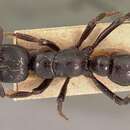en
names in breadcrumbs


Rather large, dark reddish brown or black ants with the surface of the body covered with scattered umbilicate foveolae, the spaces between which are in part at least, densely atriolate.
In the worker and female the clypeus is short and broad, its anterior border arcuate and entire. The frontal carinae are approximated, dilated and lobular and concealing the antennal insertions. The mandibles have a very peculiar shape, being long, faleate, and toothless, ending in a long acute point and broadest just beyond their basal third where the basal and apical borders meet without forming a sharp angle as in most other ants. The antennal funiculi are slightly thickened apically, with the second joint conspicuously longer than the first. Eyes small and flat, placed near the anterior quarter or third of the sides of the head. Base of epinotum with a narrow longitudinal sulcus in the middle. Premesonotal suture very distinct impressed. Mesoepinotal suture indistinct or obsolete. Petiole with high rounded node, subtruncate in front and behind. Constriction between postpetiole and gaster pronounced and provided with well-developed stridulatory surfaces. Gaster small. Middle and hind tibiae without lateral spurs, with a large pectinated median spur. The female is winged but in other respects closely resembles the worker.
The male resembles the male of Plectroctena but has smaller eyes and the mesonotum is without Mayrian furrows, the scutellum with a deep longitudinal sulcus.
Only four species of this interesting genus have been described. The Lang-Chapin collection contains a fifth, which is described below. They are all rare ants, inhabiting the virgin forest and apparently restricted to Western Equatorial Africa, from French Guinea to the Northeastern Congo (Map 14).
The workers of four species of Psalidomyrmex 1 can be readily identified by means of the following table.
1. Mandibles narrow, without distinct basal and apical borders, broadest near the middle, where they are scarcely more than one-eighth as broad as long; scapes not reaching to the posterior corners of the head; petiole longer than broad; dorsal surface of body smooth and shining between the foveolae.
reichenspergeri Santschi .
Mandibles much broader, with distinct basal and apical margins meeting at a right angle, broadest at their basal third and about one-third as broad as long; scapes reaching or surpassing the posterior corners of the head; petiole broader than long; interfoveolar surface of head, thorax and gaster, at least, finely striate.............................................2.
2. Length 9 to 10 mm. Reddish castaneous; lobes of frontal carinae smooth and shining; striae on the postpetiole longitudinal...... foveolatus Ern. André
Length about 12 mm. Brown-black or black, with brown antennae, mandibles, clypeus, and legs; striae on postpetiole arcuate........................3.
3. Head longer than broad; antennal scapes reaching beyond posterior corners of head; striae on the head, thorax, and abdomen sharp; pronotum without a median longitudinal groove; mesoepinotal suture obsolete; petiole slightly broader than long................................... procerus Emery .
Head as broad as long, antennal scapes shorter; striae on head and thorax less distinct, foveolae smaller; pronotum with a median longitudinal groove; mesoepinotal suture distinct; petiole broader........ obesus , new species .
Ouvriere. Tete un peu plus longue que large, un peu retrecie en avant, ses bords lateraux legerement arques, son bord posterieur faiblement echancre. Mandibules en triangle tres allonge, etroites, falciformes, se croisant a leur extremite qui est arquee et se termine en pointe aigue; leur bord interne obtusement denticule sur sa premiere moitie, inerme sur sa moitie apicale. Epistome tres court, transversal, presque lineaire. Areles frontales contigues, s'avancant jusqu'au bord anterieur de la tete et elargies lateralement en un lobe supraarliculaire arrondi en dehors. Sillon frontal court, formant la ligne separative des aretes frontales; aire frontale indistincte. Yeux petits, situes a peu pres au quart anterieur des bords lateraux de la tete; pas d'ocelles. Antennes de 12 articles; scape robuste, arque a sa base, elargi a son extremite et n'atteignant pas en arriere le bord posterieur de la tete; premier et deuxieme articles du funicule presque egaux, nn peu plus longs que larges, les suivants aussi larges ou un peu plus larges que longs, le dernier a peu pres aussi long que les trois precedents reunis. Profil dorsal du thorax rectiligne ou tres legerement arque, sans etranglement. Pronotum retreci en avant, a epaules arrondies, separe du mesonotum par une suture arquee, bien distincte. Suture meso-metanotale obliteree; metanotum inerme, tronque en arriere. Petiole nodiforme, plan en arriere, arrondi sur ses autres faces, retreci en avant et s'articulant a la partie inferieure du premier segment abdominal. 11 est muni, en dessous et en avant, d'une forte dent emoussee et dirigee un peu en arriere; une autre dent semblable, mais un peu plus petite et dirigee en sens inverse, se voit en dessous de la partie articulaire du premier segment abdominal, Abdomen subcylindrique, un peu retreci en avant, fortement etrangle entre le premier el le deuxieme segments qui forment a eux seuls la presque totalite de sa longueur. Patte.) ordinaires; tous les eperons pectines; ongles des tarses simples.
Par la forme de ses mandibules ce genre parait se rapprocher des Belonopelta Mayr.
Psalidomyrmex is a genus of ants in the subfamily Ponerinae.[2] The genus is known from Sub-Saharan Africa, where colonies nest in rotten wood.[3]
Psalidomyrmex is a genus of ants in the subfamily Ponerinae. The genus is known from Sub-Saharan Africa, where colonies nest in rotten wood.